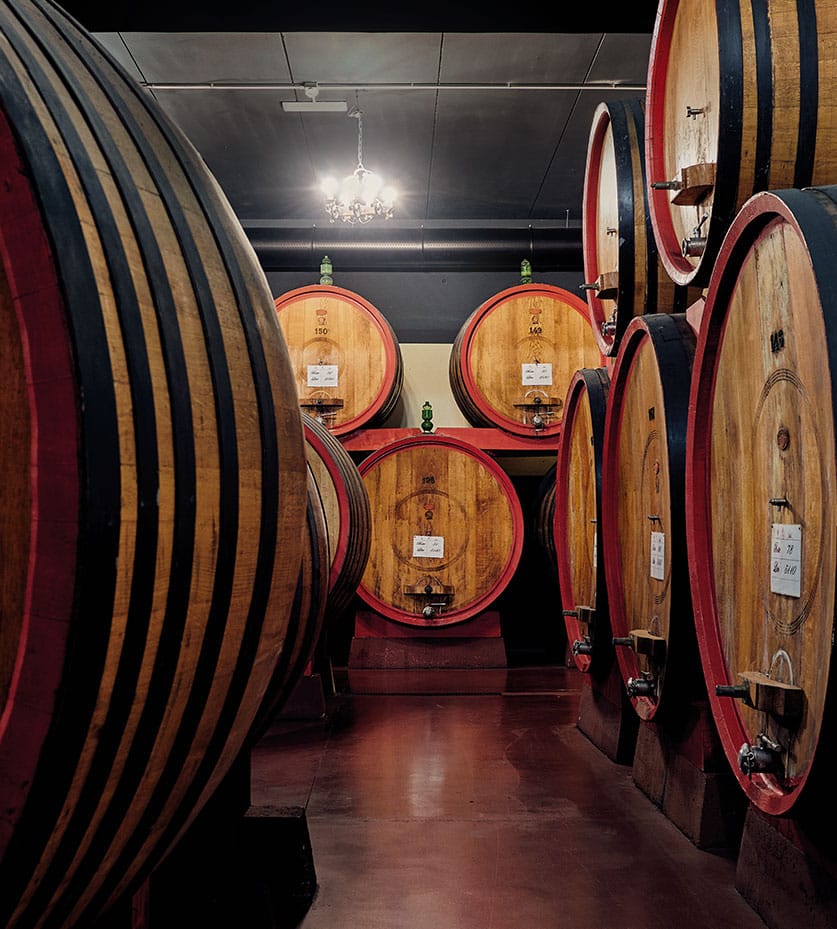Assemblage room for blending
For Citra, assemblage is quite an important phase in the production chain. Wines come from 8 production areas, which are different in terms of vineyards’ exposure and altitude, microclimates, soil composition (soil texture), vine training (tendone, vertical trellis, guyot, spurred cordon…) and harvesting techniques. Oenologists personally check the choice of best grapes and plan the harvesting. An accurate blending allows keeping our high quality standards.
Filtration Room
In this room the clarification of blended wine is carried out with a crossflow filtration by employing filters made of membranes with balanced porosity, through which wine, at a standard temperature, flows across several times until clear. Crossflow filtration allows the removal of filtered remains keeping the efficiency of the system stable.
Cooling Room
The refrigeration-filtration stage (continuous stabilization) is carried out by cooling wine at -4°C in an insulated tank, where some crystals originate and are immediately separated by a filter. In this area there are autoclaves, or tanks for the refermentation of champagne-type and sparkling wines, which consists in the wine refermentation in a close environment so that carbon anhydride obtained with the transformation of sugar into alcohol (alcoholic fermentation) gives wine its classic "perlage" feature.
Osmosis Plant
It allows reducing the salt content (demineralization), or the presence of limestone in the water that is exploited in all the production phases. This process enhances the washing of plants, tanks and filters that are used to improve their performances. Furthermore the sterilization of water, with UV rays, guarantees several important advantages also on the micro-biologic point of view.
Storage of Samples
It allows the storage of 4 bottles each batch and it is used for the managing of any potential market warnings. This procedure allows tracing back quickly the samples through their batch and production time in order to carry out: organoleptic testing, chemical analysis, checking of the packaging and quality check of raw materials.
Citra’s Quality
Citra was granted many certifications, such as ISO 9001:2008, ISO 22000 and the International BRC and IFS certifications which are always required by the biggest buying associations and big European distribution chains to safeguard the final consumer. The quality of our products is guaranteed by the carrying out of analysis on samples of the associated wineries and by the check of raw materials.
As far as corks are concerned, Citra follows a strict protocol for their selection and in this way the risk of wine to be corked is cut down.
Bootling Room
Two lines of high production (12k and 8k bottles/hour) with automatic checking for the real-time qualifying examination of empty and full bottles, as well as of boxes.
In the image contrast room, the checking of empty bottles is performed in order to reject any bottle with imperfections or presenting foreign bodies. The checking of full bottles allows detecting defects in terms of level and corking.
8.000 Line
With a maximum hourly capability of 8,000 bottles, this line allows the processing of the 0.75 litre format.
Rinser machine: it rinses bottles and drains them with a peculiar movement in order to guarantee the maximum rate of hygiene and the absence of water.
The filler, the first process to be carried out in order to guarantee the absence of oxygen is represented by an injection of a quantity of nitrogen, which is equal to the volume of the bottle’s format, and then the filling of wine is performed, generating a “layer”.
The Corking machine, for both corks and stellvin, creates a vacuum in the bottle with a depressurization system and injecting nitrogen, so that oxygen cannot reach the inside of the bottle.
The next processes are: Capping, Labelling (with glue or sticker) and Packaging with the innovative wrap-around system, which wraps cardboard around the box of bottles.
At the end of the bottling process, the checking of the box’s weight guarantees the presence of the right number of bottles and of the right quantity of wine.
12.000 Line
With an hourly capacity of 12,000 bottles, it allows the processing of all bottles’ formats: from 0.187 to 1.5 liters.
The bottling process occurs inside an area-overpressure hood (Quadriblock) in a single sterile environment. The processing is carried out with the following machineries: rinser, filler, cork/stellvin corking machine, capper, labelling and packaging.
The rinser machine cleans all bottles with sterile water and drains them in order to guarantee the absence of water. The filler is an electronic device, with groundbreaking faucets and can be set with several bottling programs according to the type of bottle, the variety of wine and the adequate treatment to be carried out.
The corking machine for cork caps presses cork pieces in order to guarantee that the cap is not damaged during its insertion, while the stelvin corking machine is used for alternative sealings, which are requested by some markets.
Then, the next steps are capping, labelling (glue or sticker) and packaging with electronic machines set to process a high number of sizes and bottles.
At the end of the bottling process, the checking of the box’s weight guarantees the presence of the right number of bottles and of the right quantity of wine.
Microfiltration plant
Designed according to specific directives given by Citra’s oenologists and technicians, it is a groundbreaking plant. The process carried out on the three filtration lines consists in the passage of wine through a series of filters with different filtering capacity ranging from 1.2 to 0.45 microns. In order to protect the quality of wine, Citra employs microfiltration as a microbiological stabilization technique, or cold bottling, as an alternative to pasteurization (hot bottling).
This innovation allows the carrying out of checking and monitoring processes on the “cleaning” and on the sterilization of plants, as well as the close checking of every activity, its traceability and the customization of all the functions set.










